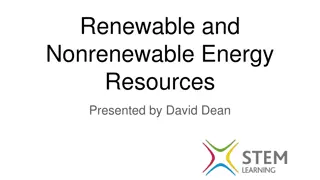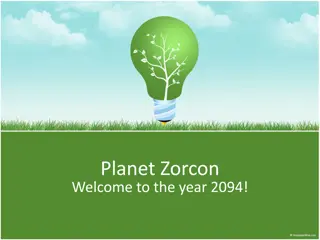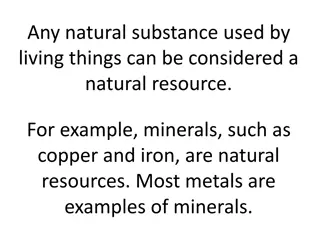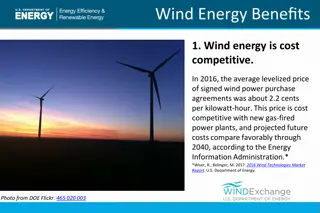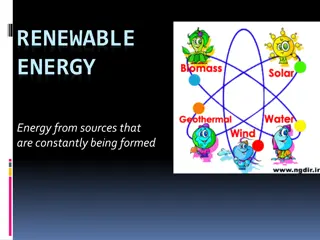Understanding the Debate on Inexhaustible vs. Nonrenewable Energy Sources
The energy debate revolves around the classification of energy sources into nonrenewable, renewable, and inexhaustible categories. Fossil fuels, such as coal, petroleum, and natural gas, fall under nonrenewable sources due to their finite nature, while wind and tidal energy are examples of inexhaustible sources. Nuclear power, derived from uranium fission, poses advantages like high energy output but raises concerns over radioactive waste disposal and resource scarcity. The ongoing discourse weighs the benefits and drawbacks of utilizing different forms of energy.
Download Presentation

Please find below an Image/Link to download the presentation.
The content on the website is provided AS IS for your information and personal use only. It may not be sold, licensed, or shared on other websites without obtaining consent from the author. Download presentation by click this link. If you encounter any issues during the download, it is possible that the publisher has removed the file from their server.
E N D
Presentation Transcript
An Energy Debate Inexhaustible? Renewable? Go green?
Current Sources of Energy Can you explain what the most common source of energy is in the United States? Do you think this type of energy is renewable or nonrenewable?
Sources of Energy Are Classified As: Nonrenewable: energy that comes from a natural resource which cannot be produced, grown, generated. Once used there is no more remaining. These resources often exist in a fixed amount and are consumed much faster than nature can create them. Examples are fossil fuels and nuclear power. Renewable: energy which comes from natural resources such as sunlight, wind, rain, tides, and geothermal heat, which are renewable (naturally replenished). Inexhaustible: energy unable to be used up because existing in abundance. Examples are wind and tidal energy.
Fossil Fuels File:Grangemouth04nov06.jpg Are fuels formed by natural processes such as decomposition of buried dead organisms. The age of the organisms and their resulting fossil fuels is typically millions of years, and sometimes exceeds 650 million years. http://upload.wikimedia.org/wikipedia/commons/thumb/b/ba/Gulf_Offshore_Platform.jpg/220px-Gulf_Offshore_Platform.jpg The fossil fuels, usually contain high percentages of carbon, include coal, petroleum, and natural gas. Renewable or Nonrenewable form of energy?
Debate Fossil Fuels Advantages Disadvantages
Nuclear Power Nuclear energy originates from the splitting of uranium atoms in a process called fission. At the power plant, the fission process is used to generate heat for producing steam, which is used by a turbine to generate electricity. Nuclear electric plants, ships, and submarines use controlled nuclear energy. Actually a form of fossil fuels. Renewable or nonrenewable form of energy?
Debate Nuclear Power Disadvantages Advantages Produces radioactive waste that is EXTREMELY dangerous Emits low amounts of CO2 Nuclear power plants could be preferred targets for terrorist attacks Available technology that does not need to be developed The energy source for nuclear energy is uranium, this is a scarce resource. (Only a 30-60 year supply at current demands). Can generate high amount of electrical energy in a single plant
Nuclear Power is Nuclear Power is being marketed today being marketed today as a cleaner and more as a cleaner and more efficient source of efficient source of power. power. A Look Into The Past - Chernobyl April 26, 1986 The Chernobyl Nuclear Power Plant in the Ukraine exploded during a systems test. The explosion sent a radioactive cloud of debris into the air that was spread across Europe due to weather conditions. Officials say it could be up to 100 years before the station is completely decommissioned. Do you believe this is Do you believe this is accurate? accurate? A 30-km (19-mile) exclusion zone is in place round the disaster site Approximately 134 power station workers were exposed to extremely high doses of radiation directly after the accident. About 31 of these people died within 3months. What are some other What are some other advantages and advantages and disadvantages of disadvantages of using nuclear power? using nuclear power? Another 25,000 liquidators the soldiers and firefighters who were involved in clean up operations have died since the disaster of diseases such as lung cancer, leukemia, and cardiovascular disease. Large families in rural areas people who farm and collect their food continue to receive large doses of radiation from the food supply.
Biomass Biomass is organic material made from plants and animals (microorganisms). Biomass contains stored energy from the sun. Plants absorb the sun's energy in a process called photosynthesis. The chemical energy in plants gets passed on to animals and people that eat them. Renewable or Nonrenewable? Renewable energy source because we can always grow more trees and crops, and waste will always exist. Ex of biomass fuels: wood, crops, manure, and some garbage.
Debate - Biomass Advantages Disadvantages Available throughout the world, and theoretically inexhaustible Minimal environmental impact Still an expensive source of energy On a small scale there is actually a net energy loss, because energy must be put in to grow the plant mass biomass energy
Wind Energy Wind is simply air in motion. It is caused by the uneven heating of the Earth's surface by the sun. Like old fashioned windmills, today s wind machines (also called wind turbines) use blades to collect the wind s kinetic energy. The wind flows over the blades creating lift, like the effect on airplane wings, which causes them to turn. The blades are connected to a drive shaft that turns an electric generator to produce electricity. Renewable or Nonrenewable? Wind is a renewable energy source because the wind will blow as long as the sun shines.
Debate Wind Energy Inexhaustible fuel source Produces no pollution Advantages Geographically limited, only areas with lots of wind are suitable for wind power generation Relatively expensive to maintain Disadvantages
Hydropower Hydropower is the renewable energy source that produces the most electricity in the United States. It accounted for 7% of total U.S. electricity generation and 35% of generation from renewable energy in 2009. Water flowing rapidly from a high point, like Niagara Falls, or quickly in a big river has lots of energy. The water flows through a pipe, or penstock, then pushes against and turns blades in a turbine to spin a generator to produce electricity. In a run-of-the-river system, the force of the current applies the needed pressure, while in a storage system, water is accumulated in reservoirs created by dams, then released as needed to generate electricity. Renewable or Nonrenewable energy source?
Debate - Hydropower Advantages Disadvantages Inexhaustible fuel source Minimal environmental impact, and can be used throughout the world Smaller models depend on availability of fast flowing rivers or streams Run-of-the-river plants can impact the mobility of fish and other river life
Geothermal The word geothermal comes from the Greek words geo (earth) and therme (heat). So, geothermal energy is heat from within the Earth. We can recover this heat as steam or hot water and use it to heat buildings or generate electricity. Naturally occurring large areas of hydrothermal resources are called geothermal reservoirs. Most geothermal reservoirs are deep underground with no visible clues showing above ground. But geothermal energy sometimes finds its way to the surface in the form of: Volcanoes, Hot springs, and Geysers. Renewable or Nonrenewable source of energy?
Debate Geothermal Power Inexhaustible energy source with no pollution Does not require structures such as solar panels or windmills to collect the energy, it can directly produce heat/energy Advantages Geographically limited not available in many locations Not much power per vent Disadvantages
Solar Resources The sun has produced energy for billions of years. Solar energy is the sun s rays (solar radiation) that reach the Earth. This energy can be converted into other forms of energy, such as heat and electricity. Photovoltaic (PV devices) or solar cells change sunlight directly into electricity. Individual PV cells are grouped into panels and arrays of panels that can be used in a wide range of applications ranging from single small cells that charge calculator and watch batteries, to systems that power single homes, to large power plants covering many acres. Concentrating Solar Power Plants generate electricity by using the heat from solar thermal collectors to heat a fluid which produces steam that is used to power the generator. Renewable or Nonrenewable form of energy? Solar energy is by far the Earth's most available energy source. Solar power is capable of providing many times the total current energy demand. But it is an intermittent energy source, meaning that it is not available at all times.
Debate Solar Resources Inexhaustible fuel source with no pollution Versatile- it is often used for powering items as diverse as solar cars and satellites Advantages Low energy production, large numbers of solar panels and large land areas are required to produce useful amounts of heat or electricity Only areas of the world with lots of sunlight are suitable for solar power generation Disadvantages










